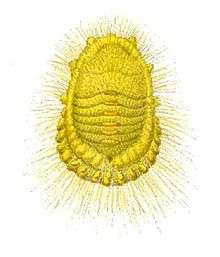Monophlebidae
| Monophlebidae | |
|---|---|
 | |
| Icerya seychellarum , female | |
| Scientific classification | |
| Kingdom: | Animalia |
| Phylum: | Arthropoda |
| Class: | Insecta |
| Order: | Hemiptera |
| Suborder: | Sternorrhyncha |
| Superfamily: | Coccoidea |
| Family: | Monophlebidae Signoret [1] |
| Genera | |
|
| |
Monophlebidae is a family of scale insects commonly known as the giant scales or monophlebids. They occur in most parts of the world but more genera are found in the tropics than elsewhere.[2]
Taxonomy
At one time, Monophlebidae was considered to be a subfamily of Margarodidae. However the family Margarodidae showed great morphological and biological variation and Maskell first recognised Monophlebidae as a separate family in 1880. The giant scales are morphologically diverse but they appear to be a monophyletic group.[1][3]
Hosts
Giant scales occur on a wide range of host plants but most of these are trees or woody shrubs.[2]
Description
Giant scales have an elongated oval body; many species grow to a length of one centimetre long and the African species Aspidoproctus maximus achieves 35 mm long.[4] The adult females of the family have six dark coloured legs and conspicuous antennae. Most genera have a waxy coating but some do not. Various species have some form of ovisac or marsupium.
Life cycle
Giant scales infest the stems, branches and leaves of their host plant. They mostly have four female and five male instars. The prepupal instar are mobile, unlike most members of other scale families. They may have wing buds and the legs and antennae are well developed.[5]
Genera[6]
- Afrodrosicha
- Aspidoproctus
- Buchnericoccus
- Conifericoccus
- Corandesia
- Crypticerya
- Drosicha
- Drosichoides
- Echinicerya
- Etropera
- Gigantococcus
- Gueriniella
- Gullania
- Hemaspidoproctus
- Icerya
- Insulococcus
- Jansenus
- Labioproctus
- Laurencella
- Lecaniodrosicha
- Llaveia
- Llaveiella
- Matesovia
- Melaleucococcus
- Misracoccus
- Modicicoccus
- Monophlebidus
- Monophleboides
- Monophlebulus
- Monophlebus
- Nautococcus
- Neogreenia
- Neohodgsonius
- Nietnera
- Nodulicoccus
- Palaeococcus
- Paracoelostoma
- Paramoandesia
- Peengea
- Perissopneumon
- Protortonia
- Pseudaspidoproctus
- Sishania
- Steatococcus
- Tessarobelus
- Vrydagha
- Walkeriana
See also
References
- 1 2 Maskell, W.M. 1880 (1879). Further notes on New Zealand Coccidae. Transactions and Proceedings of the New Zealand Institute 12: 291-301.
- 1 2 UDSA Agricultural Research Service
- ↑ Hodgson, C.J.; Hardy, N.B. (2013). "The phylogeny of the superfamily Coccoidea (Hemiptera: Sternorrhyncha) based on the morphology of extant and extinct macropterous males". Systematic Entomology. 38 (4): 794–804. doi:10.1111/syen.12030. Archived from the original on 29 December 2013.
- ↑ Alan Weaving; Mike Picker; Griffiths, Charles Llewellyn (2003). Field Guide to Insects of South Africa. New Holland Publishers, Ltd. ISBN 1-86872-713-0.
- ↑ Morales, C.F. 1991. Margarodidae (Insecta: Hemiptera). Fauna of New Zealand / Ko te Aitanga Pepeke o Aotearoa. In: Duval, C.T. (series ed.), No. 21. DSIR Plant Protection, Auckland, New Zealand. 123 pp
- ↑ http://www.sel.barc.usda.gov/scalenet/scalenet.htm
| Wikispecies has information related to: Monophlebidae |